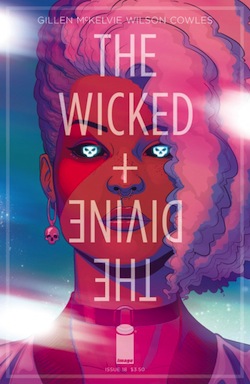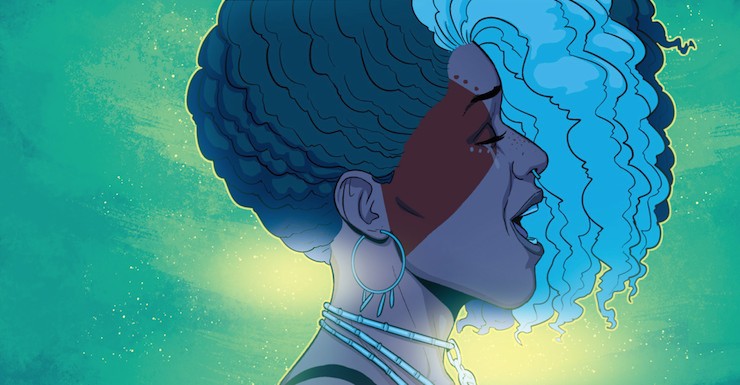Wic+Div is back, after four months hiatus, with Issue #18—and if you weren’t on board this ride already, here’s your engraved invitation. Kieron Gillen & Jamie McKelvie’s comic about gods, cult art, fame, and death (especially death) returns with an action-heavy, visual/symbolic kick to the throat from a Lucite-heeled boot: Persephone’s in Hell, but she’s also back here on earth and she has got a gig to play.
(Issue #18 is explicitly framed as a good place to join the comic if you haven’t been reading already. It’s up on Comixology as of this morning. Go have fun. I’ll be here when you get back.)
When Liz asked me if I’d like to do a Sleeps With Monsters guest column, I immediately knew I wanted to write about Wic+Div—it’s the comic that brought me back to comics after years away, got me back into cosplay (in full Morrigan regalia: raw silk, raven feathers, Annie Lennox-style black eyeshadow like a crown pulled down over the eyes— pretty much the best way to wander around Leeds Thoughtbubble Comic Art Festival), and regularly lights up the part of my brain that’s interested in apotheosis: the process of becoming a god, and why a person might want to. (And what they’d have to give up to manage it.)
Wic+Div has a fairly straightforward conceit: every ninety years, thirteen gods reemerge into the bodies of young people, who proceed to have the sort of pop star careers us mere mortals can only dream of—for two years. Within two years, they’re all dead. Until the next time around. Out of this conceit Gillen and McKelvie have precision-engineered a cult commercial success, while at the same time being entirely clear about how they are producing a story in which not only will they kill your darlings, they will do it right in front of you, over and over, and ask you to keep buying in.
There’s a blur between the world-internal mechanic of the comic and the world-external ethos of its creators which is terribly, blatantly, wink-and-grin clever. It’s knowing. It’s invitational. It’s fairly obnoxious, and I love it, because it’s played completely above-board: Gillen and McKelvie showed up to DJ the Thoughtbubble dance afterparty in the YOLO t-shirt worn by their comic’s rave-creating Dionysius: the dance floor that walks like a man.
The blur is significant, and the blur is deliberate, and part of the centrality of the liminal space of Wic+Div—the slippage between fan, pro, fiction, reality—is the comic’s ostensible protagonist, Laura Wilson. Laura’s seventeen, mixed-race, a Londoner; she starts the comic by going to a gig given by one of the gods, in full cosplay herself, trying desperately to get out of her own skin and into the bright world of the divine. Laura says to the mirror (to the audience, to the gods, to the reader): I want what you have. And who hasn’t been that girl? Especially at seventeen. Laura’s ambitious and clever and persistent, and she writes herself into the story of the reborn Pantheon (with some help from the Lord of Lies, Luci—a take on the Thin White Duke as a late-teenage girl comprised mostly of brittle, vicious fuck you watch me bravado, and probably still my favorite character in the comic). After entwining herself irrevocably in a murder mystery, a theological puzzle, and the lives of the gods—who are, in fact, people pretty much like her, when they’re not being gods—Laura gets that apotheosis she asked for.
It doesn’t go so well. It lasts—oh, two minutes? Maybe three? And then, at the close of Issue #11—approximately a quarter of the way through the prospective story arc—Laura is, apparently, killed off by the extremely dodgy god-wrangler Ananke, who has been implicated in (or directly responsible for) the deaths of several pantheon members. Ananke makes gods—and then, apparently, she unmakes them, with a snap of her fingers.
Click. (1, 2, 3, 4.) Boom. Kill your darlings. Teenage girls don’t get to be gods; being a god destroys you. (Being a creative—not a consumer but a maker—is figured throughout the comic as an act of profound danger, visceral pleasure, and ultimate disintegration: the dissolve of the self into the image. Occasionally literally, c.f. Dionysius.)
Except: the god Laura becomes is Persephone.
 And after a six-issue arc dealing with the fallout from #11—an arc that Gillen has described as the comic’s “Bowie in Berlin” period, a moody, complex, formalist sequence created in part by a series of guest artists, which digs into the past of the remaining (not-dead-yet) members of the pantheon with a scalpel brutality—Persephone’s back from the underworld in this week’s Issue #18, in full command of her suite of powers, transformed and transfigured and ready to shake shit up. She’s Wic+Div‘s tagline personified: once again we return. Turns out it’s hard to kill gods that are meant to come back every spring. (It’s rather appropriate that Issue #18 is being released in the first week of April.)
And after a six-issue arc dealing with the fallout from #11—an arc that Gillen has described as the comic’s “Bowie in Berlin” period, a moody, complex, formalist sequence created in part by a series of guest artists, which digs into the past of the remaining (not-dead-yet) members of the pantheon with a scalpel brutality—Persephone’s back from the underworld in this week’s Issue #18, in full command of her suite of powers, transformed and transfigured and ready to shake shit up. She’s Wic+Div‘s tagline personified: once again we return. Turns out it’s hard to kill gods that are meant to come back every spring. (It’s rather appropriate that Issue #18 is being released in the first week of April.)
Laura’s return—along with the return of a stylistic bombast which employs pretty much all of McKelvie’s considerable skill in drawing action scenes—reminds me of nothing so much as the front row of a Grimes gig. Girls, with all of their vicious, hungry, outsize want; more than a little dangerous, more than a little feral, the same uncontrolled sharp-edged desire, unapologetic, that writes zines and Tumblr posts and is wrenchingly confessional at the same time as it is ruthlessly performative—all of that is in Laura/Persephone, on stage at last, taking control of the narrative and rearranging it to her liking.
It is exceptionally compelling, as a statement on the possibilities of godhood. What does a god look like? Like creative work that emerges from death into rage, bravery, and desire. The fact that godhood is also embodied through an ascended fangirl, a teenager who would have (in a slightly less unreal world) been front-and-center at the latest Gerard Way concert—that, too, is compelling. The connotative universe of Wic+Div suggests that the reader—the audience—is complicit in the creation and the unmaking of gods; the slippage between solidly real and solidly unreal spheres, that triumphalist smug invitation into the game of making.
And our heroine, our identification-point, up out of the underground: well, she’s all of that uncontrollable, dangerous power of a punk kid holding her best friend’s hand and shouting along with the lyrics. She wants what they’ve got.
Now she’s got it. Here we go.
Arkady Martine writes speculative fiction when she isn’t writing Byzantine history. She is overly fond of borders, rhetoric, and liminal spaces. Find her online at arkadymartine.wordpress.com or on Twitter as @ArkadyMartine.










